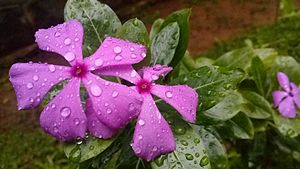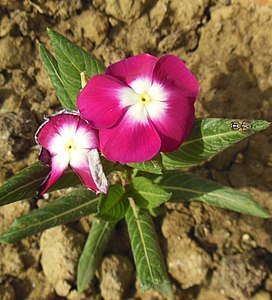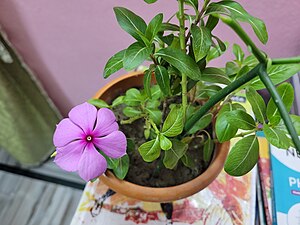Catharanthus roseus, commonly known as bright eyes, Cape periwinkle, graveyard plant, Madagascar periwinkle, old maid, pink periwinkle, rose periwinkle,[2] is a perennial species of flowering plant in the family Apocynaceae. It is native and endemic to Madagascar, but is grown elsewhere as an ornamental and medicinal plant, and now has a pantropical distribution. It is a source of the drugs vincristine and vinblastine, used to treat cancer.[3] It was formerly included in the genus Vinca as Vinca rosea.
| Catharanthus roseus | |
|---|---|
 | |
| Scientific classification | |
| Kingdom: | Plantae |
| Clade: | Tracheophytes |
| Clade: | Angiosperms |
| Clade: | Eudicots |
| Clade: | Asterids |
| Order: | Gentianales |
| Family: | Apocynaceae |
| Genus: | Catharanthus |
| Species: | C. roseus |
| Binomial name | |
| Catharanthus roseus | |
| Synonyms | |
(See also Synonyms section) | |

It has many vernacular names among which are arivotaombelona or rivotambelona, tonga, tongatse or trongatse, tsimatiririnina, and vonenina.[4]
Taxonomy edit
Two varieties are recognized
- Catharanthus roseus var. roseus
- Synonymy for this variety
- Catharanthus roseus var. angustus (Steenis) Bakh. f.[9]
Description edit

Catharanthus roseus is an evergreen subshrub or herbaceous plant growing 1 m (39 in) tall. The leaves are oval to oblong, 2.5–9 cm (1.0–3.5 in) long and 1–3.5 cm (0.4–1.4 in) wide, glossy green, hairless, with a pale midrib and a short petiole 1–1.8 cm (0.4–0.7 in) long; they are arranged in opposite pairs. The flowers range from white with a yellow or red center to dark pink with a darker red center, with a basal tube 2.5–3 cm (1.0–1.2 in) long and a corolla 2–5 cm (0.8–2.0 in) diameter with five petal-like lobes. The fruit is a pair of follicles 2–4 cm (0.8–1.6 in) long and 3 mm (0.1 in) wide.[12][13][14][15]
Ecology edit
In its natural range along the dry coasts of southern Madagascar, Catharanthus roseus is considered weedy and invasive, often self-seeding prolifically in disturbed areas along roadsides and in fallow fields. [16][17] It is also, however, widely cultivated and is naturalized in subtropical and tropical areas of the world such as Australia, Bangladesh, India, Malaysia, Pakistan, and the United States.[12] It is so well adapted to growth in Australia that it is listed as a noxious weed in Western Australia and the Australian Capital Territory,[18] and also in parts of eastern Queensland.[19]

Cultivation edit
As an ornamental plant, it is appreciated for its hardiness in dry and nutritionally deficient conditions, popular in subtropical gardens where temperatures never fall below 5–7 °C (41–45 °F), and as a warm-season bedding plant in temperate gardens. It is noted for its long flowering period, throughout the year in tropical conditions, and from spring to late autumn, in warm temperate climates. Full sun and well-drained soil are preferred. Numerous cultivars have been selected, for variation in flower colour (white, mauve, peach, scarlet, and reddish-orange), and also for tolerance of cooler growing conditions in temperate regions.
Notable cultivars include 'Albus' (white flowers), 'Grape Cooler' (rose-pink; cool-tolerant), the Ocellatus Group (various colours), and 'Peppermint Cooler' (white with a red centre; cool-tolerant).[12]
In the U.S. it often remains identified as "Vinca" although botanists have shifted its identification and it often can be seen growing along roadsides in the south.
In the United Kingdom it has gained the Royal Horticultural Society's Award of Garden Merit[20] (confirmed 2017).[21]
Uses edit
Traditional edit
In Ayurveda (Indian traditional medicine) the extracts of its roots and shoots, although poisonous, are used against several diseases. In traditional Chinese medicine, extracts from it have been used against numerous diseases, including diabetes, malaria, and Hodgkin's lymphoma.[22][13] In the 1950s, vinca alkaloids, including vinblastine and vincristine, were isolated from Catharanthus roseus while screening for anti-diabetic drugs.[23] This chance discovery led to increased research into the chemotherapeutic effects of vinblastine and vincristine. Conflict between historical indigenous use, and patent from 2001 on C. roseus-derived drugs by western pharmaceutical companies, without compensation, has led to accusations of biopiracy.[24]
Medicinal edit
Vinblastine and vincristine, chemotherapy medications used to treat several types of cancers, are found in the plant[25][26][27][28] and are biosynthesised from the coupling of the alkaloids catharanthine and vindoline.[29] The newer semi-synthetic chemotherapeutic agent vinorelbine, used in the treatment of non-small-cell lung cancer,[27][30] can be prepared either from vindoline and catharanthine[27][31] or from the vinca alkaloid leurosine,[32] in both cases via anhydrovinblastine.[31] The insulin-stimulating vincoline has been isolated from the plant.[33][34]


Research edit
Despite the medical importance and wide use, the desired alkaloids (vinblastine and vincristine) are naturally produced at very low yields. Additionally, it is complex and costly to synthesize the desired products in a lab, resulting in difficulty satisfying the demand and a need for overproduction.[35] Treatment of the plant with phytohormones, such as salicylic acid[36] and methyl jasmonate,[37][38] have been shown to trigger defense mechanisms and overproduce downstream alkaloids. Studies using this technique vary in growth conditions, choice of phytohormone, and location of treatment. Concurrently, there are various efforts to map the biosynthetic pathway producing the alkaloids to find a direct path to overproduction via genetic engineering.[39][40]
C. roseus is used in plant pathology as an experimental host for phytoplasmas.[41] This is because it is easy to infect with a large majority of phytoplasmas, and also often has very distinctive symptoms such as phyllody and significantly reduced leaf size.[42]
In 1995 and 2006 Malagasy agronomists and American political ecologists studied the production of Catharanthus roseus around Fort Dauphin and Ambovombe and its export as a natural source of the alkaloids used to make vincristine, vinblastine and other vinca alkaloid cancer drugs. Their research focused on the wild collection of periwinkle roots and leaves from roadsides and fields and its industrial cultivation on large farms.[43][44][45]
Biology edit
Rosinidin is the pink anthocyanidin pigment found in the flowers of C. roseus.[46] Lochnericine is a major alkaloid in roots.[47]
Toxicity edit
C. roseus can be extremely toxic if consumed orally by humans, and is cited (under its synonym Vinca rosea) in the Louisiana State Act 159. All parts of the plant are poisonous. On consumption, symptoms consist of mild stomach cramps, cardiac complications, hypotension, systematic paralysis eventually leading to death.[48]
According to French botanist Pierre Boiteau, its poisonous properties are made known along generations of Malagasy people as a poison consumed in ordeal trials, even before the tangena fruit was used. This lent the flower one of its names vonenina, from Malagasy: vony enina meaning "flower of remorse".[49]
Gallery edit
- Deep-red Catharanthus roseus
- This one was grown in Bangladesh as a ornamental plant in a flower tub in the balcony of a house
- Off-white Catharanthus roseus
- White with red-centered Catharanthus roseus
- Red Catharanthus roseus
- White periwinkle with thin petals
- Catharanthus roseus in Kerala
- Purple Catharanthus roseus
- Periwinkle From a garden at Cox's Bazar, Bangladesh
- Catharanthus roseus in Ishwardi, Bangladesh
- Flower bud in West Bengal, India
- Periwinkle Plant in India
- Common periwinkle plant in India
- Catharanthus roseus in Pakistan
- Grown in Malaysia
- Flower plant raised in India temples
- Seed pod and seeds
- Matured fruits of Madagascar Periwinkle
- Immature fruits of Madagascar periwinkle
- Pacifica Burgundy Halo – Madagascar Periwinkle
- Red cultivar of Madagascar Periwinkle
- Potted Plant in New Delhi
- Seeds
- A fully bloomed white plant
- A rare mutation of Periwinkle flower which causes an additional petal(6), found in Chandannagar
References edit
External links edit
 Media related to Catharanthus roseus at Wikimedia Commons
Media related to Catharanthus roseus at Wikimedia Commons Data related to Catharanthus roseus at Wikispecies
Data related to Catharanthus roseus at Wikispecies



























